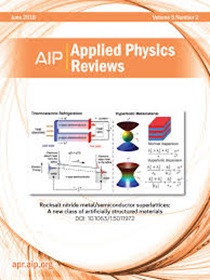纤锌矿铁电体的极化与畴:基本原理与应用
IF 11.6
1区 物理与天体物理
Q1 PHYSICS, APPLIED
引用次数: 0
摘要
2019 年关于 (Al,Sc)N 铁电性的报告[Fichtner 等人,J. Appl. Phys. 125, 114103 (2019)]打破了长期以来将 AlN 视为极性但非铁电材料教科书范例的传统。结合最近在基于 HfO2 的萤石中出现的铁电性 [Böscke 等人,Appl. Phys. Lett. 99, 102903 (2011)],这些意想不到的发现为集成铁电的研究注入了新的活力,研究团队争先恐后地了解这些新材料的基本原理和/或在商业设备中部署这些新材料--或者更正确地说,具有吸引力的旧材料的新功能。铁电 (Al,Sc)N [Fichtner 等人,J. Appl. Phys. 125, 114103 (2019)]的开创性报告发表以来的五年尤其令人振奋,最近的评论文章 [Jena 等人,Jpn.J. Appl. Phys. 58, SC0801 (2019);Wang 等人,Appl.124, 150501 (2024);Kim 等人,Nat.Nanotechnol.18, 422-441 (2023);以及 F. Yang, Adv.Mater.11, 2400279 (2024)].在此,我们将重点讨论铁电沃特盐如何使该领域重新思考畴壁和极化反转过程--包括自发极化本身的特性--超越主要基于包晶氧化物的经典理解,并在各种注意事项的基础上扩展到其他化学物质。与经典铁电系统相比,氮化铝的四面体和高共价键以及相应的大带隙导致了掺杂/合金化、缺陷补偿和电荷分布方面的根本差异;再加上渥兹体结构的单极性对称性,最终产生了一类既熟悉又令人费解的铁电材料,其特性似乎对现代集成器件来说是完全有利的,但同时也是不可行的。这篇综述的目的是(相对)快速地让读者了解目前--至少到 2025 年初--对钨锆铁电体中的畴和缺陷的理解,涵盖这些材料的基础科学中最相关的工作以及器件结构早期演示中一些最令人兴奋的工作。本文章由计算机程序翻译,如有差异,请以英文原文为准。
Polarization and domains in wurtzite ferroelectrics: Fundamentals and applications
The 2019 report of ferroelectricity in (Al,Sc)N [Fichtner et al., J. Appl. Phys. 125, 114103 (2019)] broke a long-standing tradition of considering AlN the textbook example of a polar but non-ferroelectric material. Combined with the recent emergence of ferroelectricity in HfO2-based fluorites [Böscke et al., Appl. Phys. Lett. 99, 102903 (2011)], these unexpected discoveries have reinvigorated studies of integrated ferroelectrics, with teams racing to understand the fundamentals and/or deploy these new materials—or, more correctly, attractive new capabilities of old materials—in commercial devices. The five years since the seminal report of ferroelectric (Al,Sc)N [Fichtner et al., J. Appl. Phys. 125, 114103 (2019)] have been particularly exciting, and several aspects of recent advances have already been covered in recent review articles [Jena et al., Jpn. J. Appl. Phys. 58, SC0801 (2019); Wang et al., Appl. Phys. Lett. 124, 150501 (2024); Kim et al., Nat. Nanotechnol. 18, 422–441 (2023); and F. Yang, Adv. Electron. Mater. 11, 2400279 (2024)]. We focus here on how the ferroelectric wurtzites have made the field rethink domain walls and the polarization reversal process—including the very character of spontaneous polarization itself—beyond the classic understanding that was based primarily around perovskite oxides and extended to other chemistries with various caveats. The tetrahedral and highly covalent bonding of AlN along with the correspondingly large bandgap lead to fundamental differences in doping/alloying, defect compensation, and charge distribution when compared to the classic ferroelectric systems; combined with the unipolar symmetry of the wurtzite structure, the result is a class of ferroelectrics that are both familiar and puzzling, with characteristics that seem to be perfectly enabling and simultaneously nonstarters for modern integrated devices. The goal of this review is to (relatively) quickly bring the reader up to speed on the current—at least as of early 2025—understanding of domains and defects in wurtzite ferroelectrics, covering the most relevant work on the fundamental science of these materials as well as some of the most exciting work in early demonstrations of device structures.
求助全文
通过发布文献求助,成功后即可免费获取论文全文。
去求助
来源期刊

Applied physics reviews
PHYSICS, APPLIED-
CiteScore
22.50
自引率
2.00%
发文量
113
审稿时长
2 months
期刊介绍:
Applied Physics Reviews (APR) is a journal featuring articles on critical topics in experimental or theoretical research in applied physics and applications of physics to other scientific and engineering branches. The publication includes two main types of articles:
Original Research: These articles report on high-quality, novel research studies that are of significant interest to the applied physics community.
Reviews: Review articles in APR can either be authoritative and comprehensive assessments of established areas of applied physics or short, timely reviews of recent advances in established fields or emerging areas of applied physics.
 求助内容:
求助内容: 应助结果提醒方式:
应助结果提醒方式:


